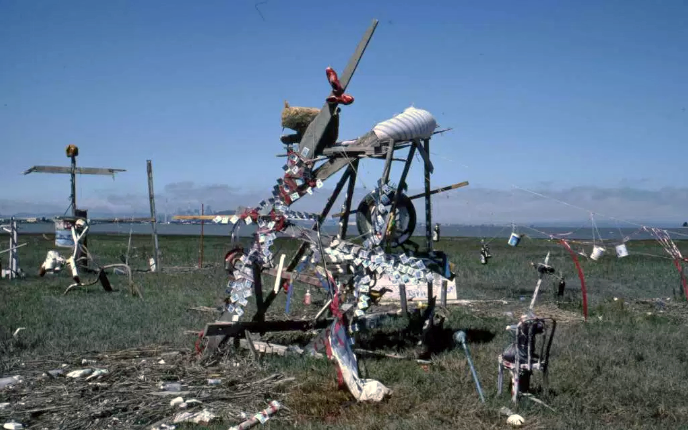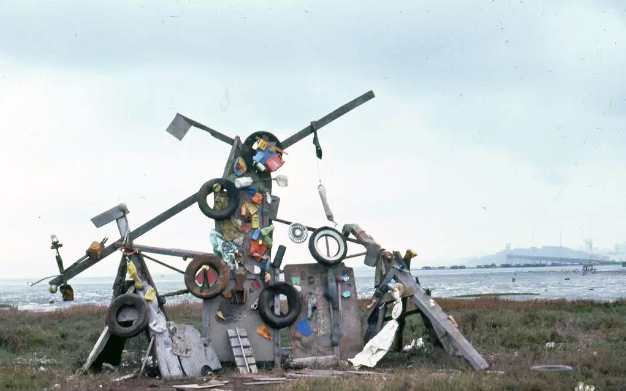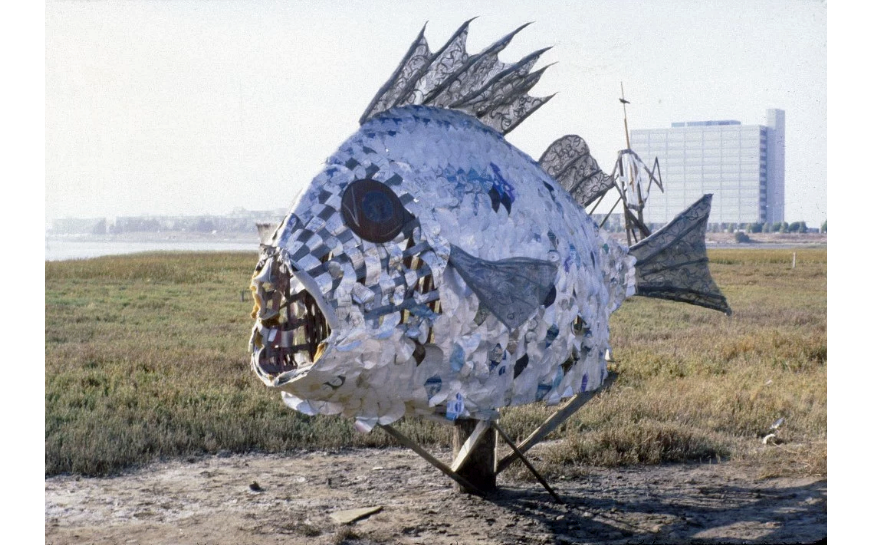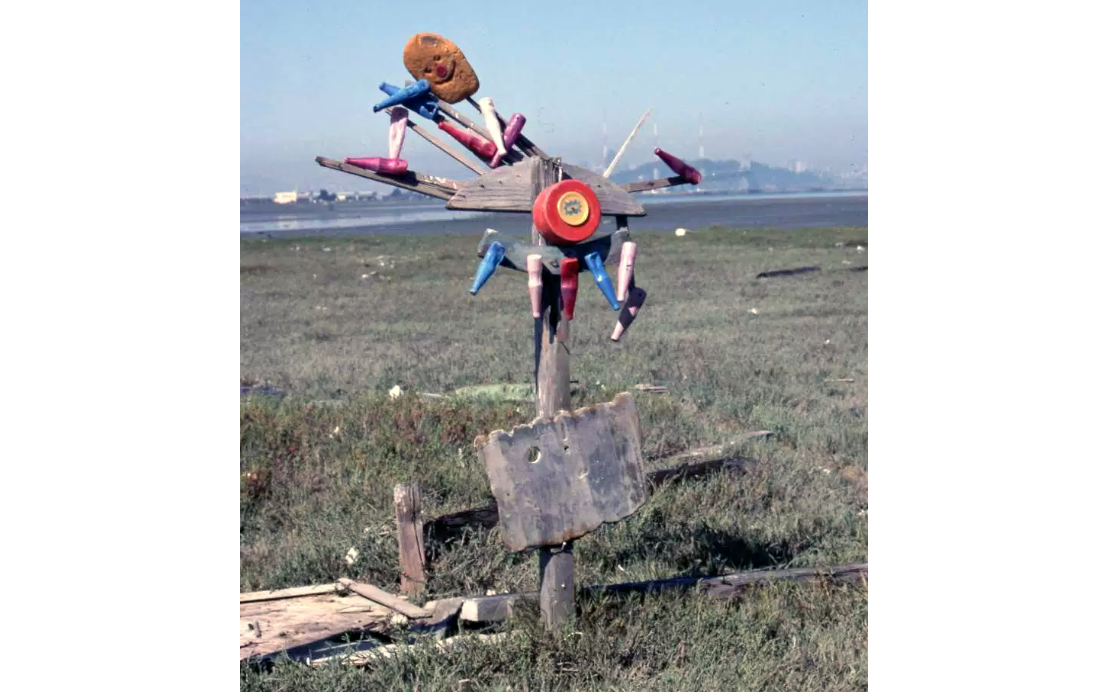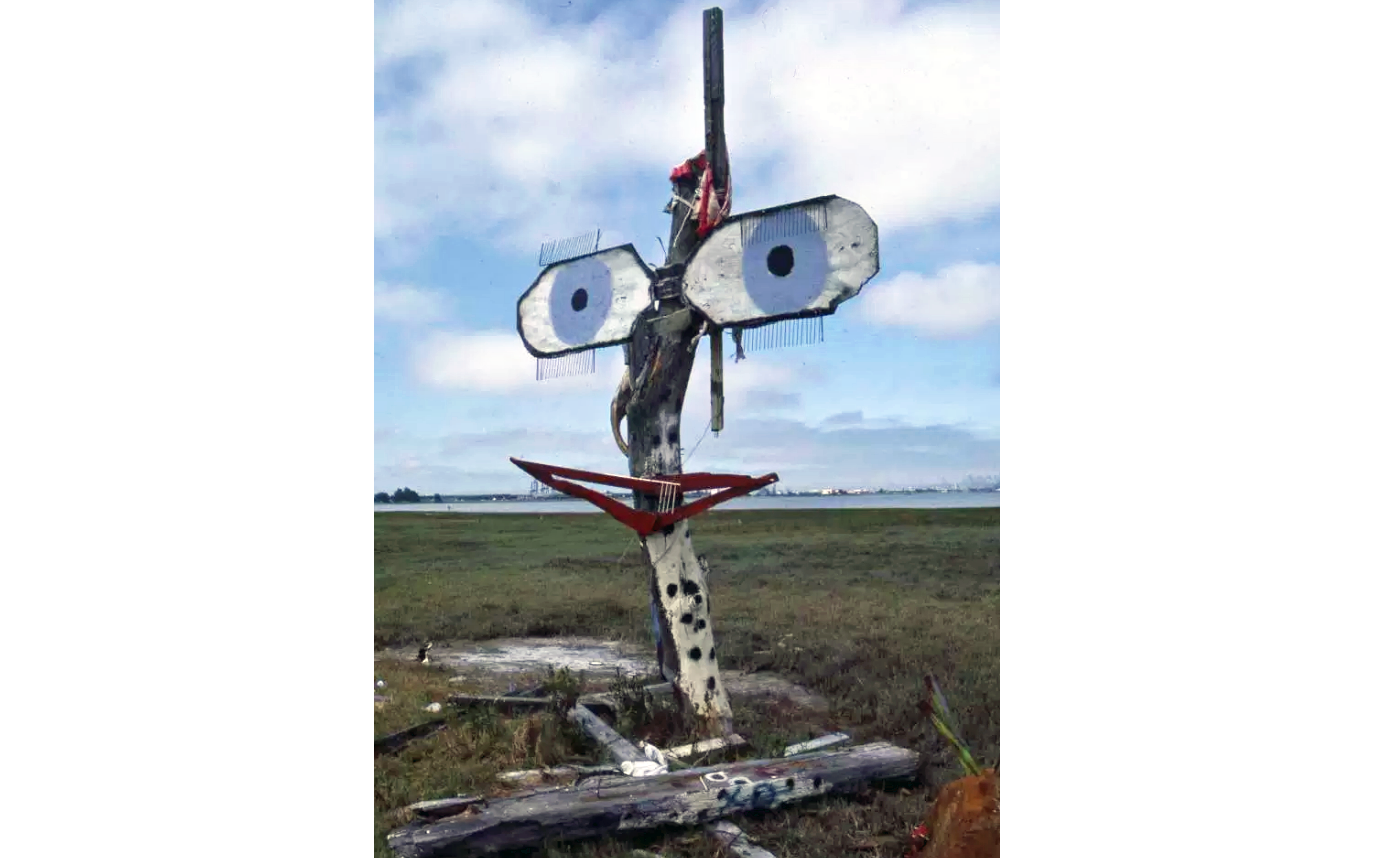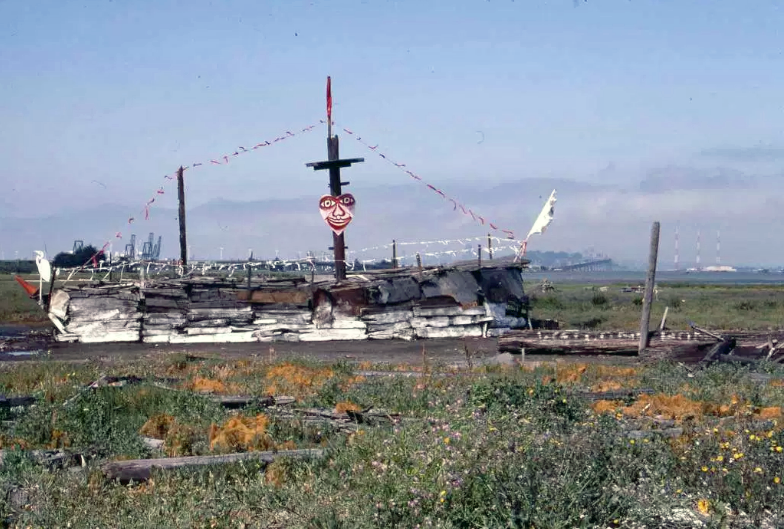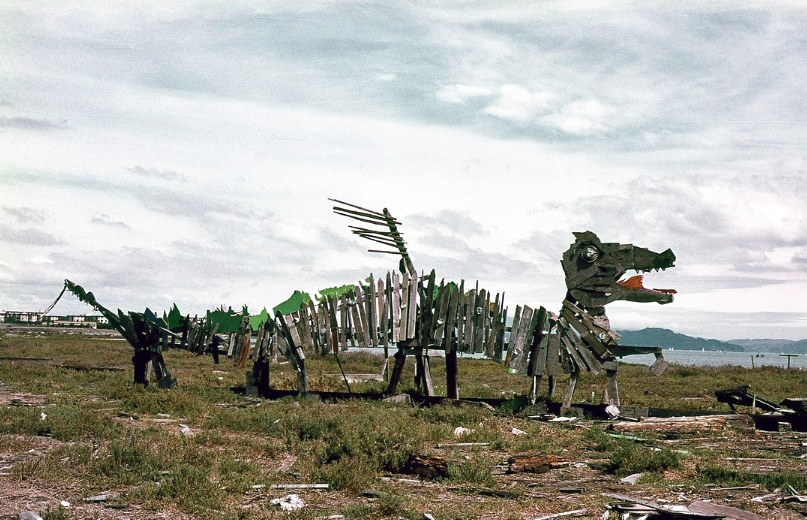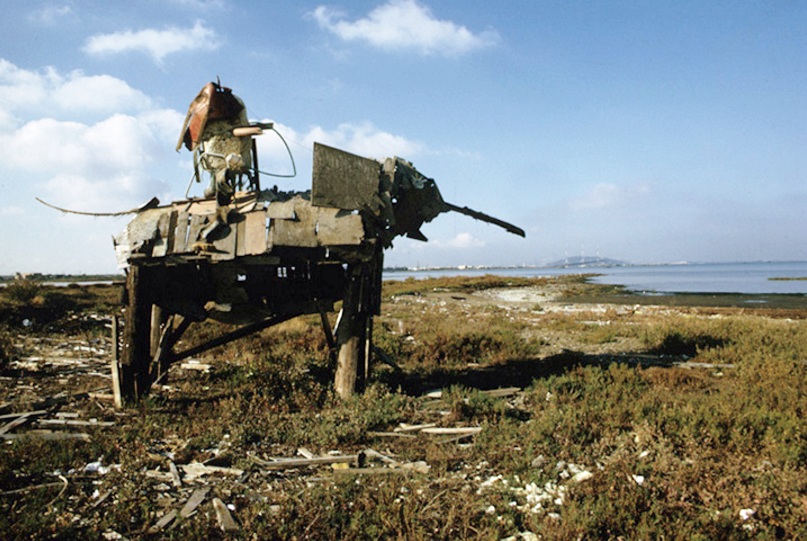Then ... we next see them amongst a collection of makeshift sculptures alongside a freeway on the edge of the bay - the distant sign at far right gives us a first clue as to the location.
... and Now, the scene was filmed on the east bay Emeryville mudflats alongside Highway 80 (map). Those office buildings and the Hilton hotel (formerly a Holiday Inn) have since been built on the Watergate Peninsula.
Then ... As the camera zooms in the freeway sign becomes more clearly visible at the Powell Street overpass. ...
... and Now, it can't be seen now from the mudflats (blocked by trees), but the sign is still there, viewed here from Powell Street.
By triangulation using this sign and a distant view seen in another shot CitySleuth was able to home in on the scene's location, immediately south of the Watergate Peninsula.
The mudflats were a magnet for driftwood and industrial flotsam. Anonymous artists began fashioning these found objects into sculptures around 1960 and continued off and on until 1985 when the area was designated a State Marine Reserve and cleaned up. Here's a c. 1980 photo of the sculpture garden with the partially constructed Watergate Peninsula complex in the background.
See a gallery of sculptures that appeared here over the years by clicking or tapping the image below.
Getting back to the movie ... as Harold lovingly clasps Maude's hand he is jarred at the sight of an I.D. number tattooed on her arm, a peek into her past.
Then ... but she pretends not to notice and, seeing a flock of seagulls against the golden sunset, tells him that the French Jewish political prisoner Alfred Dreyfus used to watch birds from his island prison, thinking of them as 'glorious birds' but disappointed years later to realize they were only seagulls. "For me", she says, "they will always be glorious birds". A symbol of freedom perhaps, for a Holocaust survivor?
... and Now, the view towards San Francisco spans, from left to right: Twin Peaks, downtown San Francisco, Treasure Island, Bay Bridge east tower, Golden Gate Bridge, the headlands and hills of Marin County and at far right the tip of the Watergate Peninsula; its parallax position against the Marin hills was the second clue to the scene's location.
The mudflats didn't only host whimsical artworks; often there were social or political messages too, as for example this 'End War' sign in 1971 when Vietnam weighed heavily on the conscience of the nation.
Harold and Maude was filmed in 1971 - it is quite possible that director Hal Ashby was inspired by the sign and planned on taking it a step further with a stronger message ... but the footage ended up on the cutting room floor; here's an outtake image.
Back around 1910 when this movie's story was set mass media entertainment as we know it today did not exist. Radio didn't become widespread until the 1920s; television the early 1950s. Even silent movies, initially individually shown in nickelodeons, didn't take off until the advent of luxury movie theaters beginning in 1915. So where could the Hanson family and their contemporaries go out for entertainment? Well, they could see live performances at one of the many vaudeville theaters across town, visit Playland-At-The-Beach, go swimming at Sutro Baths, or go skating at a rink. The bold amongst them could place bets at the races. These and other forms of entertainment were widely advertised across town by large eye-catching posters, some of which we get a glimpse of in the background of scenes from I Remember Mama.
When Mama and Katrin were out shopping the keen of eye would have noticed the posters plastered on a door across the street, partially hidden by the flower stall canopy. One advertises the Pantage Theater and the other Skating at the Coliseum.
A small theater, the Empire at Sutter and Steiner, was renamed the Pantage from 1908 to 1911 but that poster would be advertising the much better known 1800 seat Pantage vaudeville theater that opened in 1911 at 941 Market Street. Here's a postcard image, viewed south from 5th Street, showing how it looked before being converted into a department store in 1926.
... coming soon, at the site today the ground has recently been broken for a $150 million, 250,000 square foot urban mall to be called Market Street Place, the latest contribution to the ongoing Mid Market revival. Here's a rendering of how it will look.
In this shot there's another Coliseum poster and one advertising the Orpheum Theater. The Coliseum poster clearly shows the address as Baker and Oak Streets.
... a vintage photo ... the Coliseum roller skating rink, pictured here in 1913, spanned the Baker Street block between Fell and Oak opposite Golden Gate Park's panhandle in the Upper Haight. As an added attraction evening sessions there would sometimes include ragtime dancing on skates. A monument to President McKinley, erected in 1904 three years after his assassination, faces the entrance.
... and Now, the Coliseum is long gone; its site today is occupied by San Francisco's DMV office (map). The McKinley statue is still there, a constant target for graffiti tagging, the irksome malaise of modern times.
... a vintage photo ... The Orpheum advertised in the movie image above was the 2300 seat theater at 147 O'Farrell Street near Union Square (map), pictured here in 1910 after it was rebuilt following the great earthquake. It was renamed the Columbia Theater in 1929 but was torn down in 1937, a victim of the Great Depression.
... and Now, the Ellis - O'Farrell parking structure is at this site today. The same building on the right however is still there, newly refurbished - how nice to have these century-old architectural reminders dotted around town.
During a walk on Telegraph Hill Katrin and her sister pass by a poster for an amusement park, Idora Park (the poster showing the full name can be seen in the on-location still included in the previous post).
... a vintage photo ... Here's a panorama of Idora Park taken in 1910. The Victorian era entertainment park on 17 acres opened in 1904 and closed in 1929. Trumpeted as one of the Wonders Of The West, it offered numerous rides including a roller coaster, a skating rink, a shooting gallery, a stadium for 5,000, an opera theater, picnic grounds and much more. If you full-size the image (click or swipe it) perhaps you can find the Hanson family amongst the crowd - then again maybe not since they had so few pennies to rub together.
The park was bounded by Shattuck, Telegraph, 56th and 58th in North Oakland (map). It's at the center of this 1912 map detail.
The girls walked past another poster, this one exhorting folks to come place their bets on the horses at the New California Jockey Club.
The New California Jockey Club was the name given in 1896 to the renovated Oakland Trotting Park which had been open since 1871 as a mile-long racetrack for harness and thoroughbred racing. Unfortunately for them horse racing was banned by the State in 1911 and after trying out automobile and airplane racing the track was demolished in 1915. This 1912 map shows the track, still referring to it as the Oakland Trotting Park. The site is now an industrial zone; today both the Novartis Research Institute and Pixar Animation Studios overlap the site of the old racetrack, centered at Hollis and 53rd in Emeryville (map).

